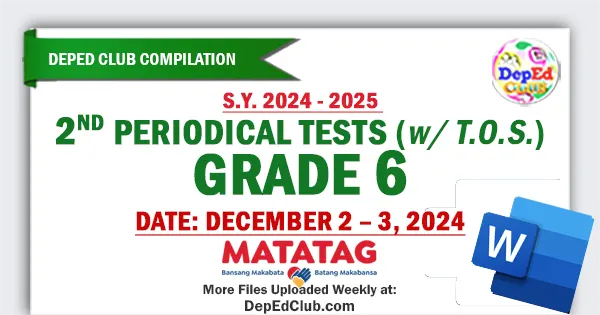Using Effective Assessment Techniques in Teaching
Effective teachers use a mix of formal and informal assessments to understand student learning levels and progress. For formal evaluation, teachers rely on quizzes, tests, exams, assignments and reports. These tools help gauge individual achievement and assign grades which are known as summative evaluations. These assessments such as these GRADE 6 (Matatag Soon) – 2nd Periodical Tests with TOS | SY 2024 – 2025 typically occur at the end of lessons, units, or courses to measure cumulative learning.
In addition to formal assessments, teachers also use informal techniques to get a real-time understanding of student comprehension. They ask questions, observe body language and listen to student feedback. This type of assessment called formative evaluation, allows teachers to adjust their teaching strategies immediately. If students appear confused, teachers might slow down or review the material; if students show confidence, they can proceed to new concepts. Formative assessments aim to improve learning rather than assign grades.
Classroom assessment techniques are a structured approach to formative assessment. They are simple, targeted tools that help teachers collect quick feedback on student learning enabling them to adjust their teaching methods as needed. Each technique is designed to answer specific questions about what and how well students are learning. These techniques provide immediate feedback and supplement formal assessments by offering ongoing insights before and between tests reducing surprises for both teachers and students when grading periods arrive.
Classroom assessment techniques also complement informal evaluation techniques helping teachers make their assessments more structured and systematic. Many classroom assessment techniques leave a record of student feedback which teachers and students can refer to later. This written feedback supports the teacher’s memory which can often fade between classes, allowing them to prepare more effectively.
DepEd 2nd Periodical Tests Schedule
DECEMBER 2 – 3, 2024
(Monday – Tuesday )
DepEd 2nd Quarter Examination Schedule School Year 2024 – 2025
SOURCE: DepEd School Calendar and Activities for School Year 2024-2025
Since teachers have diverse goals, styles and student needs, classroom assessment techniques come in a variety of forms and complexities. Some techniques are more flexible, easier to administer, or simpler for students to respond to accommodating a wide range of teaching environments. When used effectively, classroom assessment techniques not only enhance classroom learning but also create a continuous loop of feedback that supports student success.

GRADE 6 (Matatag Soon) – 2nd Periodical Tests with TOS |
SY 2024 – 2025
- NOW YOU CAN: PREVIEW CONTENTS AND DISCUSSION (CLICK HERE)
- GRADE 6 2nd Periodical Test in ARALING PANLIPUNAN 6
- GRADE 6 2nd Periodical Test in ENGLISH 6
- GRADE 6 2nd Periodical Test in EPP 6
- GRADE 6 2nd Periodical Test in ESP 6
- GRADE 6 2nd Periodical Test in FILIPINO 6
- GRADE 6 2nd Periodical Test in MATHEMATICS 6
- GRADE 6 2nd Periodical Test in MSEP 6
- GRADE 6 2nd Periodical Test in SCIENCE 6
- NOW YOU CAN: PREVIEW CONTENTS AND DISCUSSION (CLICK HERE)
